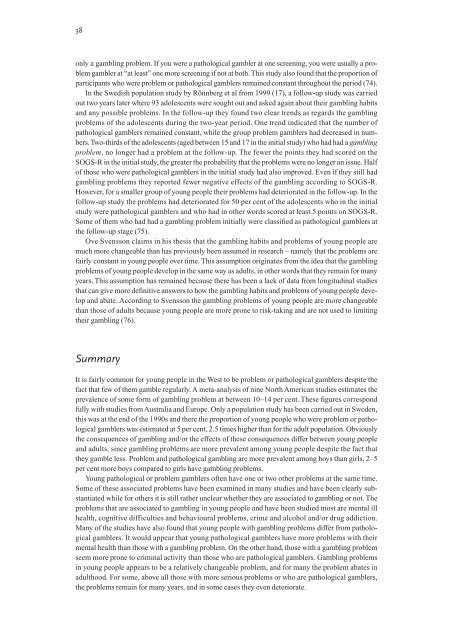Gambling Among Young People, 837 kB
Gambling Among Young People, 837 kB
Gambling Among Young People, 837 kB
Create successful ePaper yourself
Turn your PDF publications into a flip-book with our unique Google optimized e-Paper software.
38<br />
only a gambling problem. If you were a pathological gambler at one screening, you were usually a problem<br />
gambler at “at least” one more screening if not at both. This study also found that the proportion of<br />
participants who were problem or pathological gamblers remained constant throughout the period (74).<br />
In the Swedish population study by Rönnberg et al from 1999 (17), a follow-up study was carried<br />
out two years later where 93 adolescents were sought out and asked again about their gambling habits<br />
and any possible problems. In the follow-up they found two clear trends as regards the gambling<br />
problems of the adolescents during the two-year period. One trend indicated that the number of<br />
pathological gamblers remained constant, while the group problem gamblers had decreased in numbers.<br />
Two-thirds of the adolescents (aged between 15 and 17 in the initial study) who had had a gambling<br />
problem, no longer had a problem at the follow-up. The fewer the points they had scored on the<br />
SOGS-R in the initial study, the greater the probability that the problems were no longer an issue. Half<br />
of those who were pathological gamblers in the initial study had also improved. Even if they still had<br />
gambling problems they reported fewer negative effects of the gambling according to SOGS-R.<br />
However, for a smaller group of young people their problems had deteriorated in the follow-up. In the<br />
follow-up study the problems had deteriorated for 50 per cent of the adolescents who in the initial<br />
study were pathological gamblers and who had in other words scored at least 5 points on SOGS-R.<br />
Some of them who had had a gambling problem initially were classified as pathological gamblers at<br />
the follow-up stage (75).<br />
Ove Svensson claims in his thesis that the gambling habits and problems of young people are<br />
much more changeable than has previously been assumed in research – namely that the problems are<br />
fairly constant in young people over time. This assumption originates from the idea that the gambling<br />
problems of young people develop in the same way as adults, in other words that they remain for many<br />
years. This assumption has remained because there has been a lack of data from longitudinal studies<br />
that can give more definitive answers to how the gambling habits and problems of young people develop<br />
and abate. According to Svensson the gambling problems of young people are more changeable<br />
than those of adults because young people are more prone to risk-taking and are not used to limiting<br />
their gambling (76).<br />
Summary<br />
It is fairly common for young people in the West to be problem or pathological gamblers despite the<br />
fact that few of them gamble regularly. A meta-analysis of nine North American studies estimates the<br />
prevalence of some form of gambling problem at between 10–14 per cent. These figures correspond<br />
fully with studies from Australia and Europe. Only a population study has been carried out in Sweden,<br />
this was at the end of the 1990s and there the proportion of young people who were problem or pathological<br />
gamblers was estimated at 5 per cent, 2.5 times higher than for the adult population. Obviously<br />
the consequences of gambling and/or the effects of these consequences differ between young people<br />
and adults, since gambling problems are more prevalent among young people despite the fact that<br />
they gamble less. Problem and pathological gambling are more prevalent among boys than girls, 2–5<br />
per cent more boys compared to girls have gambling problems.<br />
<strong>Young</strong> pathological or problem gamblers often have one or two other problems at the same time.<br />
Some of these associated problems have been examined in many studies and have been clearly substantiated<br />
while for others it is still rather unclear whether they are associated to gambling or not. The<br />
problems that are associated to gambling in young people and have been studied most are mental ill<br />
health, cognitive difficulties and behavioural problems, crime and alcohol and/or drug addiction.<br />
Many of the studies have also found that young people with gambling problems differ from pathological<br />
gamblers. It would appear that young pathological gamblers have more problems with their<br />
mental health than those with a gambling problem. On the other hand, those with a gambling problem<br />
seem more prone to criminal activity than those who are pathological gamblers. <strong>Gambling</strong> problems<br />
in young people appears to be a relatively changeable problem, and for many the problem abates in<br />
adulthood. For some, above all those with more serious problems or who are pathological gamblers,<br />
the problems remain for many years, and in some cases they even deteriorate.

















